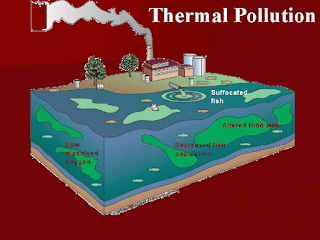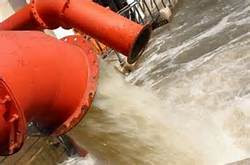The problems in freshwater
ecosystems caused by heat
There are various effects on the biology of the ecosystems when heated effluents reach the receiving waters.
The species that are intolerant to warm conditions may disappear, while others, rare in unheated water, may thrive so that the structure of the community changes.
 Thermal pollution can have a great influence on the aquatic ecosystem. Species that are restricted to heated waters, can build up large populations in the receiving waters.
Thermal pollution can have a great influence on the aquatic ecosystem. Species that are restricted to heated waters, can build up large populations in the receiving waters.
Respiration and growth rates may be changed and these may alter the feeding rates of organisms. The reproduction period may be brought forward and development may be speeded up. Parasites and diseases may also be affected.
An increase of temperature also means a decrease in oxygen solubility. Any reduction in the oxygen concentration of the water, particularly when organic pollution is also present, may result in the loss of sensitive species.
Where does heated water come from?
Possibly the most damaging environmental effect of a power station is the many organisms that may be sucked in through the water intake.
Possibly the most damaging environmental effect of a power station is the many organisms that may be sucked in through the water intake.
 Larger creatures, such as fish, are killed on the intake screens while smaller species pass through the plant. Even algae may be damaged, with permanent impairment of the photosynthetic mechanism.
Larger creatures, such as fish, are killed on the intake screens while smaller species pass through the plant. Even algae may be damaged, with permanent impairment of the photosynthetic mechanism.
Liquid water changes temperature slowly because it can store a large amount of heat without a large change in temperature. This high heat capacity helps protect living organisms from temperature fluctuations, moderates the earth’s climate and makes water an excellent coolant for car engines, power plants and heat-producing industrial processes.
 But when water is used in the industry, it is hot and it will be spilled through a discharge pipe into a river. This increase in temperature will reduce the amount of oxygen in the river.
But when water is used in the industry, it is hot and it will be spilled through a discharge pipe into a river. This increase in temperature will reduce the amount of oxygen in the river.
That can affect the level of oxygen freely available to organisms, which in turn affects respiration and essentially their way of life.
 For example, the metabolism rate is largely dependent upon the temperature of an animal's body. Animals display several different types of thermal adaptations to their environment.
For example, the metabolism rate is largely dependent upon the temperature of an animal's body. Animals display several different types of thermal adaptations to their environment.
Two particularly prevalent types include ectotherms and endotherms.
In ectotherms (an animal whose body temperature varies with the temperature of its surroundings; any animal except birds and mammals), the body temperature will be low in a cold environment and high in a warm environment.
 For example, in summer fish may have high metabolic rates because their body temperatures are elevated in the warm water.
For example, in summer fish may have high metabolic rates because their body temperatures are elevated in the warm water.
At the same time they are faced with relatively low oxygen availability because warm water holds less dissolved oxygen than cold water.
 The interaction of these factors may prove critical. For this reason there is a growing concern among ecologists about the heating of aquatic habitats by effluents from industrial and nuclear generating facilities.
The interaction of these factors may prove critical. For this reason there is a growing concern among ecologists about the heating of aquatic habitats by effluents from industrial and nuclear generating facilities.
Heated water can kill animals and plants that are accustomed to living at lower temperatures.
RELATED POSTS:
..
..
.
Gases in Freshwater
.
.
.
.
.
.
CLICK HERE . . .
http://puricare.blogspot.com/2016/04/gases-in-freshwater-when-gases-occur-in.html..
..
 .Difference Between Acid Rain and Normal Rain
.Difference Between Acid Rain and Normal Rain
CLICK HERE . . .
http://puricare.blogspot.com/2016/09/acid-rain-and-normal-rain-water-is.html.......
http://puricare.blogspot.com/2016/09/acid-rain-and-normal-rain-water-is.html.......
..
PURICARE
INDUSTRIAL
ENTERPRISES
Water
Treatment
Systems
 |
| Ultraviolet Bactericidal System with Cartridge Pre-Filters . . ..... . |








Hello, an amazing Information dude. Thanks for sharing this nice information with us. Wastewater Treatment Equipment
ReplyDelete